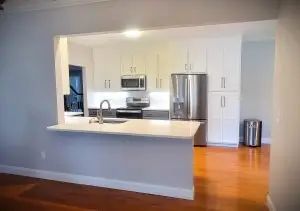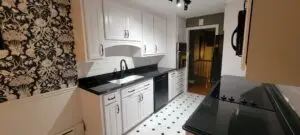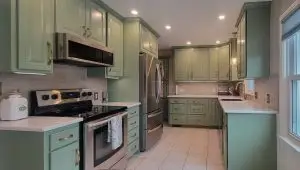When the time comes to update your kitchen, the options can be overwhelming. Among the most popular methods for transforming the look of your kitchen are cabinet refacing and cabinet refinishing. These approaches offer distinct benefits and drawbacks, tailored to different homeowner needs and preferences. This detailed comparison will delve into the nuances of each method, providing a clearer perspective on why cabinet refacing might be the superior choice for those seeking a significant kitchen upgrade.
Understanding Cabinet Refinishing
Cabinet refinishing is a process that involves keeping your current cabinet structures intact while updating their color or finish. This method typically requires sanding down the existing cabinets to remove old paint or stain, then applying a new coat of paint or stain. Refinishing is an attractive option for homeowners satisfied with their kitchen’s layout and the condition of their cabinets but desiring a fresh look or updated color scheme.
The Process of Cabinet Refacing
Cabinet refacing, in contrast, is a more comprehensive approach to kitchen updates. It involves removing and replacing cabinet doors, drawer fronts, and hardware, and covering the existing cabinet boxes with a new veneer that matches your chosen style. This method can dramatically alter the appearance of your kitchen, allowing for a change in style, color, and even hardware types. Refacing is ideal for those looking to make a significant aesthetic change without the extensive costs and time associated with a complete kitchen renovation.
Key Differences Explained
- Visual Impact: Cabinet refacing can completely transform your kitchen’s style, offering modern, traditional, or custom designs. Refinishing, while effective for updating color, is limited to the existing layout and cabinet design.
- Durability and Quality: New materials used in refacing are often superior in resisting wear and tear, moisture, and fading. Refinished cabinets retain their original materials, which may not be as resilient.
- Investment and Value: Initially, refinishing may seem more cost-effective. However, the long-term benefits and value added to your home from refacing often outweigh the upfront savings of refinishing.
- Project Timeline: Refinishing projects are typically quicker due to their simpler nature. Refacing, while more time-consuming, results in a more substantial upgrade to your kitchen’s aesthetics and functionality.
- Eco-Friendliness: Refacing is a greener option, as it repurposes existing cabinet structures, reducing landfill waste. Refinishing also has eco-friendly aspects, especially if using low-VOC paints or stains.
The Case for Cabinet Refacing
While both refinishing and refacing have their merits, several factors make cabinet refacing the preferable choice for a comprehensive kitchen update:
- Transformative Potential: Cabinet refacing offers the ability to completely overhaul the look of your kitchen, including changes in style, color, and hardware. This can create a space that feels entirely new, reflecting current trends or your personal taste.
- Enhanced Home Value: Kitchens play a crucial role in home valuation. A refaced kitchen, with its updated appearance and functionality, can significantly boost your home’s market appeal and value.
- Quality and Longevity: The materials used in refacing are typically of higher quality than those used in original cabinets or a refinishing project. This means your refaced cabinets will likely last longer and withstand daily use better.
- Cost-Effectiveness: Though more expensive than refinishing, refacing is considerably less costly than a full kitchen remodel. It offers a middle ground for homeowners seeking a major upgrade without the major expense.
Deep Dive into Refacing Benefits
Refacing allows for an extensive range of design and material choices, from natural wood veneers to laminates and thermofoil, each offering unique benefits. This variety enables homeowners to tailor their kitchen’s look to exact specifications, something refinishing cannot match. Furthermore, refacing can be an opportunity to address other kitchen functionality improvements, such as the addition of new drawers, pull-out shelves, or soft-close hinges, enhancing the kitchen’s overall utility and convenience.
Sustainability and Eco-Conscious Choices
In today’s eco-conscious world, refacing offers a sustainable option for kitchen renovations. By reusing the cabinet boxes and minimizing waste, refacing reduces the environmental impact associated with kitchen updates. This approach aligns with the growing trend towards more environmentally responsible home improvements, offering homeowners a way to reduce their carbon footprint while achieving their desired kitchen aesthetics.
Conclusion
Cabinet refinishing and cabinet refacing serve different homeowner needs, preferences, and budgets. Refinishing may appeal to those looking for a simple color update and minimal disruption. However, for those desiring a comprehensive kitchen transformation, cabinet refacing emerges as the clear winner. It not only provides a dramatic aesthetic upgrade but also enhances functionality, adds to home value, and offers a more durable and sustainable solution.
Choosing between refinishing and refacing depends on your project goals, budget, and how much of a change you’re looking for. If your aim is to achieve a kitchen that feels brand new, reflects the latest design trends, and adds substantial value to your home, then cabinet refacing is undoubtedly the way to go. With its blend of transformative potential, quality, and cost-effectiveness, cabinet refacing offers a compelling solution for those ready to take their kitchen from outdated to outstanding.




